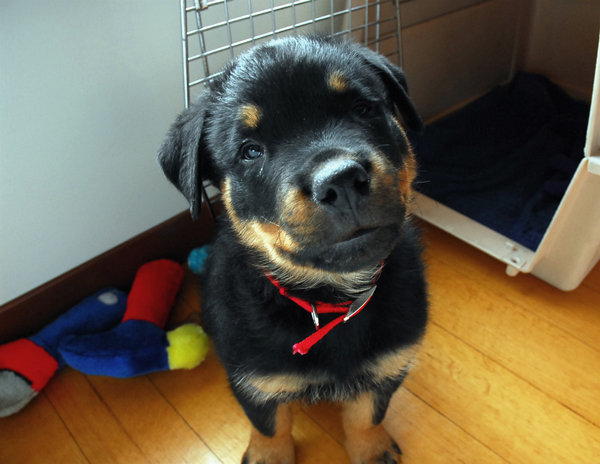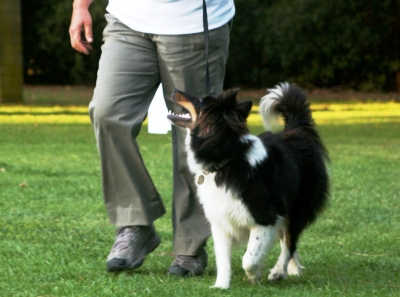
When Sadie first came into my life four years ago, she was what I would call a reactive dog, lunging towards and barking viciously at any dog that walked past or came close to her. In the first five years of her life with another family, she had obviously learned to protect herself by behaving in a threatening manner. In her mind, each time she aggressed, she kept herself safe by making sure no dog came into her space, and by the time she came to live with me, the behavior was so deeply ingrained, it had become a well rehearsed ritual. Fortunately I was able to temper her reaction and teach her a new way to cope and behave in similar situations. The techniques I used meant I could change her behavior without physically punishing or imposing my will upon her in any way. I just gave her choices.
Teaching dogs to make choices is not a new concept, but is something that I have used for many years to guide dogs into making better decisions in all kinds of situations. Because modern day dog training is still polluted by the more traditional punishment based methodology, the idea of teaching your dog to make choices has been somewhat pushed into the background, but the beauty of this method is that it works, and yes, even with the aggressive or ‘red zone’ dogs.
It saddens me how dogs are manipulated and pushed around. For example I regularly see owners and trainers teaching their dogs to sit by pressing down on their poor animals’ backsides, or punishing them by poking, kicking or restraining them on their sides or backs in an effort to dominate and gain control. The flawed idea that a dog will only learn to behave through force and fear is sad and misguided, but people are still misled into thinking that these methods are the right way to go. This leads to elevated stress levels that could be avoided if time was taken to understand how dogs’ learn and how they can be taught effectively. Choice training is a beacon of hope in what is still a dominating world.
Teaching your dog to make the right choices involves catching actions and behaviors that you like and marking them with rewards that your dog finds motivating. These actions and behaviors can then be the dog’s ‘default’ behaviors that he or she can use in certain situations. A default behavior gives the dog an alternative and makes him more positively confident in a situation that previously made him insecure. The dog is then gradually exposed to increasingly stressful situations and is watched to see what alternative behavior he offers. If the behavior is something that counters a previously undesirable behavior, the dog is rewarded. If he chooses negative behavior, he is quietly removed from the situation until he is in a place where he can learn again.
The only way Sadie knew how to deal with a scary situation was to lunge and aggress. Suppressing that behavior with punishment would have probably worked momentarily, but as in most cases, punitive suppression does not change the way a dog feels, but merely puts a bandage on the problem, which is likely to resurface again in a similar situation. Not only that, it is simply wrong to punish a dog for being nervous or insecure and only serves to make the insecurity worse. I changed Sadie’s behavior by showing her that not only was there another way to behave, but it actually made her feel better.

I began by teaching her a variety of actions she could use, such as sit, walk on and watch me and paired her success with rewards she loved, which ensured that her learning process was a fun and enjoyable one. I then taught her a combination of actions. Whenever she looked at a dog in the distance, I said look and rewarded her for looking but not reacting. I then asked her to watch me and when she turned her head towards me, she got another reward. After many repetitions (and a very kind friend who brought her dog along and worked with us) she was eagerly looking at the strange dog and back at me because the action was now reinforcing for her. I then faded out the food reward I gave her for looking at the dog and used it only at the end of the sequence – when she looked back at me. As the dog came closer we continued with the sequence. At no time did Sadie have her back to the approaching dog. If Sadie reacted negatively at any point, I turned her away and took her to a place where she felt safer and learning could continue again. Because Sadie is highly motivated by food she easily learned the process. We quickly got to the point where she could watch the other dog walk past with no reaction whatsoever.
I repeated the sequence with a number of different dogs and then when I believed Sadie was ready to make her choice, faded my cues out of the picture. Would she used the series of alternative behaviors I had taught her or revert back to lunging and aggressing? I gave her a loose lead and stood still, as a dog that Sadie had never seen before, approached. Saying and doing nothing I waited for her to make her choice. Each time she looked at the dog and back at me I smiled and quietly praised her, but at no time did I issue a cue or do anything else. When the dog walked by, Sadie watched him and then looked back at me. I could see in her eyes how happy she was and rewarded her for her bravery. She knew she had accomplished something that day, and as we continued over the next several weeks, her confidence increased and her new ‘choice’ behavior became fixed.
I can’t tell you how wonderful it is for me to see a dog learn, think for themselves and grow in confidence through success. It is what makes my job so rewarding. Of course, I start the process by giving dogs’ alternatives, but at the end of the day they are the ones that make the final choice. The beauty of this training is that it encourages dogs to think for themselves while gaining confidence from the choices they make, without being pushed, punished or physically manipulated in any way. My presence was still important for many months, as it gave Sadie confidence, but she was gradually able to walk with other people and is now even greeting other dogs successfully on and off the leash. Lunging and barking was not only stressful for her, but exhausting. Her ‘choice’ in comparison, requires little energy and the rewards are much more satisfying for her. Sadie will never be a highly social dog because of her past experiences, but she now has a group of canine friends that has made her life infinitely more rewarding.

This is a great method for teaching all kinds of reactive and fearful dogs, but can also be useful when teaching pups and adults simple cues. For example when I teach a dog to ‘sit’ on cue, all I do is find out what motivates the dog, be it a toy or treat, and hold the motivator in front of them. The dog then has to work out how he is going to get the reward out of my hand. He might try a variety of actions such as pawing, licking or nibbling at my hand but the reward is not given until he puts his bottom on the ground. As soon as he does so, he gets the reward and this is repeated again and again until I am ready to put a cue word to the action of sitting.
For so long dog training has been about force, fear and physical manipulation, which renders the dog into some kind of performing robot and doesn’t allow for the dog to think for himself. It might sound strange to those well versed in the more dominant style of training, but all dogs, regardless of breed and drive, have evolved to have excellent problem solving skills, and therefore have the ability to think for themselves, be guided to listen, take direction and make the right choices.





































